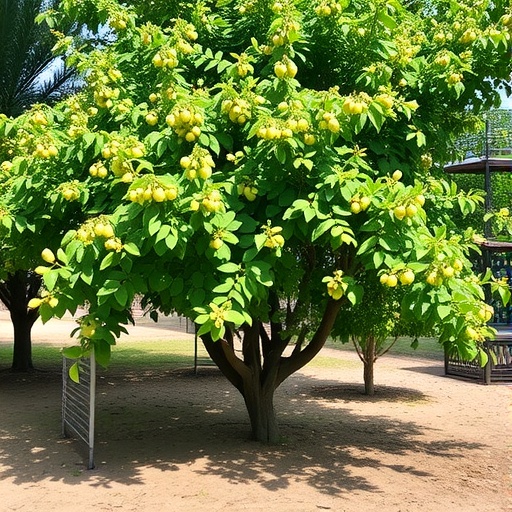In a groundbreaking study published in the prestigious journal Scientific Nature, researchers have unveiled insightful findings on the phenotypic and functional trait variation of Malvastrum coromandelianum, a plant species commonly found in Pakistan. This research, conducted by Zahra, Ahmad, and Asghar, along with a team of dedicated scientists, represents a significant advancement in our understanding of plant adaptation and ecological dynamics.
The study meticulously examined how different tree plantation types influence the growth and functional traits of Malvastrum coromandelianum. This plant, often regarded as a weed, has been studied in various contexts; however, its response to specific environmental conditions created by different tree species has remained largely unexplored until now. This innovative research sheds light on the intricate relationships between flora and their habitat, highlighting the complexities of ecological interactions.
One of the core aspects of this study focused on the phenotypic variations observed in Malvastrum coromandelianum. Phenotypic traits such as leaf size, growth rate, and reproductive output were measured across various tree plantations. The findings reveal that the plant exhibits remarkable plasticity, adjusting its characteristics based on the surrounding flora. This adaptability is not only fascinating from a botanical perspective but also crucial for understanding how invasive species could affect biodiversity in tree-dominated ecosystems.
Furthermore, the functional traits of Malvastrum coromandelianum, which refer to the ecological roles and contributions of the plant within its environment, were assessed. The research indicates that the species plays a significant role in soil health and nutrient cycling, especially in regions dominated by specific types of trees. The implications of these findings could inform future conservation strategies, especially in the context of managing invasive species and promoting biodiversity.
In addition to phenotypic and functional traits, this study delves into the environmental stressors impacting Malvastrum coromandelianum. Factors such as soil composition, moisture levels, and light availability were methodically analyzed. The results suggest that the plant not only survives but flourishes in various conditions, showcasing resilience and adaptability that could prove advantageous in rapidly changing environments influenced by climate change.
The research methodology employed in this study involved a combination of field studies and controlled experiments. By rigorously observing Malvastrum coromandelianum across different plantation types, the researchers were able to draw robust conclusions supported by empirical data. This methodological rigor is a hallmark of scientific research, ensuring that the findings are both credible and scientifically relevant.
One striking outcome of this research is its potential applications in sustainable agriculture and forestry. Understanding how Malvastrum coromandelianum interacts with different tree species can lead to innovative strategies for crop rotation and agroforestry practices. By leveraging the benefits of this adaptable plant, farmers and land managers may enhance soil health and promote ecological balance within agricultural systems.
As the dialogue around biodiversity and ecosystem services intensifies, studies like this one contribute vital knowledge to ongoing conversations about conservation and sustainable management. The ability of Malvastrum coromandelianum to thrive in varied environments may provide insights into the resilience of other plant species facing similar ecological pressures. This knowledge could be instrumental in informing conservation efforts worldwide.
By documenting the intricate connections between Malvastrum coromandelianum and the tree species within its environment, Zahra and her colleagues open avenues for further research. Future studies could focus on gene expression and the physiological mechanisms underpinning the adaptability of this plant. Such research would deepen our understanding of plant ecology and evolution, providing important insights for biodiversity conservation.
The impact of human activity on ecosystems cannot be understated, and this research highlights the implications of tree plantation management on plant diversity. As forests face increasing pressures from logging, urbanization, and climate change, understanding how individual species respond to these shifts is crucial. The findings from this study can inform policymaking around land use and forest management, promoting practices that support ecological integrity.
Moreover, the interplay between tree species and Malvastrum coromandelianum reflects broader themes in ecology, such as interspecific competition and niche differentiation. This research adds another layer to the understanding of how invasive and native species coexist, adapt, and potentially outcompete one another. Such dynamics are essential for predicting future ecological outcomes as ecosystems continue to evolve.
The advances made in this study underscore the importance of comprehensive ecological research in developing effective conservation strategies. By understanding not only the traits of individual species but also their functional roles within ecosystems, scientists and conservationists can better address the challenges faced by global biodiversity.
Ultimately, the work of Zahra, Ahmad, Asghar, and their team presents a compelling case for the intricate relationships between plants and their environments. As the scientific community gathers more data on Malvastrum coromandelianum and similar species, the collective knowledge can aid in optimizing conservation efforts and fostering sustainable practices that support both agricultural productivity and ecological health.
In conclusion, the research on phenotypic and functional trait variation in Malvastrum coromandelianum presents an essential contribution to the field of plant ecology. By exploring how various tree plantations influence this adaptable plant, the authors provide critical insights that could shape future biodiversity conservation approaches. The continuous exploration of such relationships will be pivotal in our fight to understand and preserve the delicate balance of ecosystems around the world.
Subject of Research: Phenotypic and functional trait variation in Malvastrum coromandelianum.
Article Title: Phenotypic and functional trait variation in Malvastrum coromandelianum under different tree plantations in Pakistan.
Article References:
Zahra, A., Ahmad, F., Asghar, A. et al. Phenotypic and functional trait variation in Malvastrum coromandelianum under different tree plantations in Pakistan.
Sci Nat 112, 52 (2025). https://doi.org/10.1007/s00114-025-02003-0
Image Credits: AI Generated
DOI: https://doi.org/10.1007/s00114-025-02003-0
Keywords: Phenotypic variation, functional traits, Malvastrum coromandelianum, tree plantations, biodiversity, ecological dynamics, adaptation, conservation.




